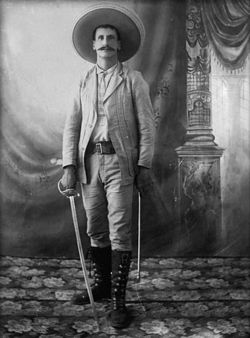Domingo Arrieta issues
The Arrieta brothers, from the Sierra Madre of Durango, were among the first to take up arms in 1910 in support of Francisco Madero. Then after Huerta’s coup d’état in February 1913 they rebelled again. On 18 June their forces captured the city of Durango, and installed Pastor Rouaix as provisional governor. Domingo Arrieta met with Carranza in Durango in August 1913, and was appointed a General and Comandante Militar of the state.
In January 1914 Pastor Rouaix wrote to Carranza complaining about the difficulties that Arrieta was causing and to ask Carranza to resolve the problem. He said that Arrieta was printing $1,000,000 in bonos. He had tried to convince him of the damage that would be done to business and to government if military jefes issued paper currency without any backing. Rouaix had told Arrieta that he (Rouaix) had Carranza’s permission to issue notes and was already engraving the plates, and he offered to give Arrieta whatever sum he needed for his expenses. Arrieta said that he had had problems receiving funds but Rouaix claimed that the government had always paid and the fault lay with the fact that Arrieta’s brigade did not have a paymaster or keep books. Rouaix asked Carranza to order Arrieta to suspend his issue, and to decide the amount that the government should pay daily to meet his expensesABarragán, caja IV, exp. 31, f.58-72.
So Arrieta's first attempt was probably an issue under the title of Jefatura de Hacienda del Eército Consitucionalista.
The Jefatura de Hacienda del Ejército Constitucionalista
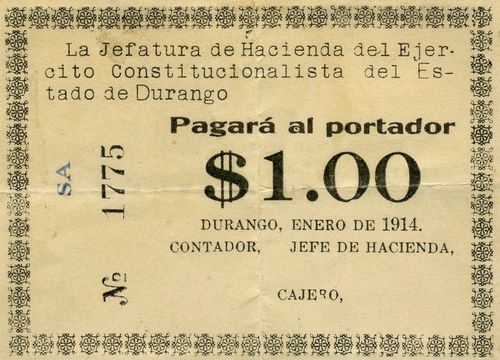
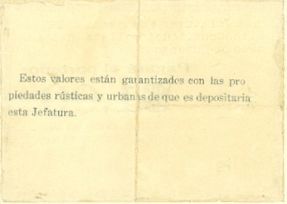 M1456 $1 Jefatura de Hacienda
M1456 $1 Jefatura de Hacienda
| Series | from | to | total number |
total value |
||
| $1 | SA | includes number 1775CNBanxico #10869 to 11479 |
The example illustrated is unsigned but has space for the signatures of the Contador, Jefe de Hacienda and Cajero and on the reverse the claim that the issues is backed by confiscated properties (Estos valores están garantizados con las propiedades rústicas y urbanas de que es depositaria esta Jefatura). The fact that these notes (a) have a simple design comparable to the first Estado de Durango notes, (b) were Series A (abbreviated to 'SA') and that a later Arrieta $1 issue was Series B (SA), and (c) do not appear to have been issued all suggests that they were an unfulfilled Arrieta project.
On 11 January 1914 Carranza, from Navojoa, Sinaloa, told governor Pastor Rouaix that he had sent a telegram to Domingo Arrieta that he was going to nominate a Jefe de Hacienda to administer all the federal services and integrate the issue of paper money that Arrieta had been authorised to pay (Enterado sus mensajes del 9 creo que de acuerdo con Sr Gobernador se habrá nombrado Jefe de Hacienda en esa mientras va el nombrado por esta primera magistratura del Ejercito Constitucionalista a fin de crear todos los servicios federales, y por conducto del cual procurare ministrar los y a quien pueda integrar parte de la emision de papel moneda que he autorizado á Vd lance a la circulacion para pago de haberes que expresada Jefatura ser entienda con la Sria de hacienda adscrita a esta primera Jefatura y con expresados Jefes)ADUR, Fondo Secretaria General de Gobierno (Siglo XX), Sección 6 Gobierno, Serie 6.7 Correspondencia, caja 7, nombre 12.
On 9 March 1914 Francisco Rios Laurenzana told Domingo Arrieta that the government did not have the necessary guarantee for the first issue of more than $200,000 so could not give his brigade what it needed for its expensesADUR, Libro Copiador 267, Hacienda 11 July 1913 - 25 April 1914, p849.
Incidentally, in June 1914 the Jefe de Hacienda in office was J. Manuel MuñozADUR, Libro Copiador 279, Hacienda 25 April 1914 - 27 July 1914, p212.
|
J. Manuel Muñoz was the foreman of Silvestre Terrazas’ newspaper in Chihuahua, El Correo. He appears as Interventor on the dos caritas, dating from March 1914. By February 1915 Muñoz was using headed notepaper that showed him to be a ‘Comerciante y comisionista’ in Durango. and at that time was acting as the Jefe de HaciendaADur, Fondo Secretaria General de Gobierno (Siglo XX), Sección 6 Gobierno, Serie 6.7 Correspondencia, caja 6, nombre 62. After Villa was defeated, Muñoz emigrated to the United States and worked as a printer for the Newspaper Printing Corporation in El Paso for more than 26 years before he retiredEl Paso Herald-Post, 5 September 1955. He died on 17 November 1971El Paso Times, 19 November 1971. |
First issue
Domingo Arrieta took over as provisional governor from Pastor Rouaix on 14 August 1914. That month there was another issue of $5 and $50 notes, with the same design as Pastor Rouaix's issue and with Carranza’s authorization still on the reverse, but with the signatures of Arrieta as governor, Juan B. Fuentes as secretary and José Clark as Director General de RentasCámara Nacional de Comercio e Industria de la Ciudad de Durango, 1915-1940, México, D. F. 1941, p 100 claims that this issue was printed in Guadalajara, the major part in Litográficos y Tipográficos del Miguel Gómez.
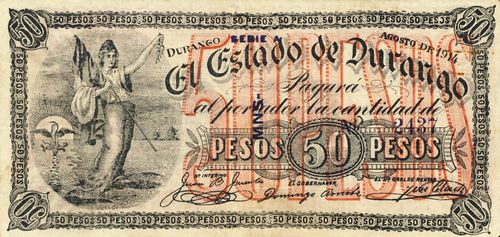
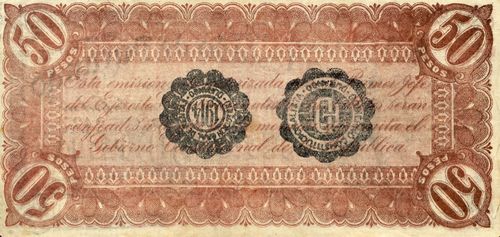 M1496a 50c Estado de Durango
M1496a 50c Estado de Durango
In July 1914 Salvador Dorador (presumably Silvestre Dorador's son) was sent to Monterrey to buy paper for printing the bonosADUR, Libro Copiador 284, Pastor Rouaix 19 May 1914 - 7 August 1914, p99 and ADUR, Fondo Secretaría General de Gobierno, Sección Siglo XIX, Serie Correspondencia, Subserie Revolución, gaveta 6, nombre 31. On 6 August Dorador was in El Paso to pick up a consignment of 100 reams100 resmas de papel de lino, marca Bond, de 40 libras sent by the National Paper and Typewriter Co. of MonterreyADUR, Libro Copiador 284, Pastor Rouaix 19 May 1914 - 7 August 1914, pp.149-151.
On 18 August Arrieta asked Carranza for permission to issue more currency to pay his troops and on 21 August was authorised to issue up to $1,000,000. By 24 he had started the issuePeriódico Oficial, Durango, Tomo XXXIX, Núm. 18,30 August 1914. The statement (corte de caja) for the Dirección General de Rentas, now signed by José Clark, records $625,000 issued from 11 to 31 AugustPeriódico Oficial, Durango, Tomo XXXIX, Núm. 10, 10 September 1914.
On 22 September Carranza authorized Arrieta to issue up to another(?) million pesos for the forces under his commandPeriódico Oficial, Durango, Tomo XXXIX, Núm. 14, 27 September 1914. In a later telegram to CarranzaCEHM, Fondo XXI-4, telegram Arrieta to Carranza 13 January 1916. The telegram actually list 10,000 $5 notes valued at $500,000, but this is just a typo. Figures confirmed in a telegram from A. Gaxiola D., Durango, to Villarreal, Mexico City, on 21 December 1914 (ADUR, Libro Copiador 278, Telegramas 13 August 1914 - 23 April 1915, p269) Arrieta acknowledged that he had issued the following amounts (figure in telegram corrected):
| Date on notes | Denom. | Series | Number | from | to | Value | Total |
| August 1914 | $5 | E | 100,000 | 1 | 100000 | $500,000 | |
| $50 | A | 10,000 | 1 | 10000 | 500,000 | $1,000,000 |
Perversely, the Dirección General de Rentas' corte de caja for September originally stated that it issued $500,000Periódico Oficial, Durango, Tomo XXXIX, Núm. 15, 8 October 1914 but a later version recorded no issuePeriódico Oficial, Durango, Tomo XXXIX, Núm. 23, 29 November 1914.
The Villista Severino Ceniceros officially took over as Comandante Militar and Gobernador on 29 September but even the day before he had announced that while Arrieta's $5 series E and $50 Series A were valid and of forced circulation, his $5 Series F were not, since they had not been authorisedPeriódico Oficial, Durango, Tomo XXXIX, Núm. 15, 8 October 1914. So there were series F notes before December (below).
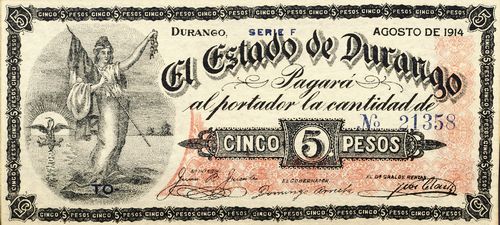
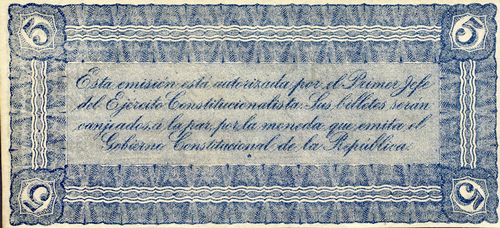 M1495a $5 Estado de Durango
M1495a $5 Estado de Durango
A telegram from Antonio Gaxiola to Secretary of Finance Villarreal in Mexico City, on 21 December 1914, reported that there were 10,000 Series A notes, and 100,000 Series E notes. The writer did not know the amount of Series F since the forces had sacked the press on leavingADUR, Libro Copiador 278, Telegramas 13 August 1914 - 23 April 1915, p269.
The codes (at least for the $5 notes) repeated themselves in batches. Known codes are:
$5 notes
| Series | from | to | total number |
total value |
code letters |
|
| E | OIY | vertical: includes number 3033 | ||||
| LPS | includes number 5430 | |||||
| UGT | includes number 13726 | |||||
| ERA- | includes number 20749 | |||||
| OIY | vertical: includes number 27731 | |||||
| LPS | includes number 29782CNBanxico #3994 | |||||
| ERO- | includes number 31612CNBanxico #10906 | |||||
| GFA | includes number 33122CNBanxico #3975 | |||||
| UGT | includes number 37509 | |||||
| MIR | includes number 42741 | |||||
| UGT | includes numbers 49286 and 49715 | |||||
| MA-A | includes numbers 58495 and 70566CNBanxico #10904 | |||||
| EID | includes number 76852 | |||||
| MA-A | includes numbers 82419 and 82945 | |||||
| UGT | includes number 85932 | |||||
| L-AR | vertical: includes numbers 86009 and 86532 | |||||
| LPS | includes number 89846CNBanxico #3984 | |||||
| GON | includes number 91262 | |||||
| ITE | vertical: includes number 96229 | |||||
| 100,000 | $500,000 | |||||
| F | N-RI | vertical | ||||
| ACB | vertical includes number 26790CNBanxico #3991 |
|||||
| NI | includes number 32250CNBanxico #10907 | |||||
| TO- | includes number 33917CNBanxico #3985 | |||||
| ED | includes number 34593CNBanxico #3992 | |||||
| UAN | includes number 66724CNBanxico #3993 | |||||
$50 notes
| Series | from | to | total number |
total value |
code letters |
||
| $50 | A |
MNS- | vertical | ||||
| DDP | vertical includes number 00382CNBanxico #10908 |
||||||
| ECS | includes numbers 00956CNBanxico #4009 to 01384CNBanxico #4003 | ||||||
| OTA | includes number 04434CNBanxico #4007 | ||||||
| IE-E | includes number 05300CNBanxico #4010 | ||||||
| Z-IO | includes number 06530CNBanxico #4004 | ||||||
| BER | includes number 07505CNBanxico #4008 | ||||||
| NNE- | includes number 8950CNBanxico #4006 | ||||||
| 09999 | S-A | includes number 09832CNBanxico #4005 | |||||
| 10,000 | $500,000 |
On 1 September 1914 Mariano Arrieta wrote to Domingo Arrieta from Mexico City asking him to order the Jefe de Hacienda not to pay in bonos without the stamp of the corresponding JefaturaADUR, Fondo Secretaria General de Gobierno (Siglo XX), Sección 6 Gobierno, Serie 6.7 Correspondencia, caja 6, nombre 46.
On 7 October 1914 the Secretario Interino, Antonio Gaxiola, told the Jefe Político of Cuencamé that the bonos were of forced circulation except for Series FADUR, Libro Copiador 278, Telegramas 13 August 1914 - 23 April 1915, p48.
Second issue
In November 1914 Zacatecas included in its list of forced issues the $5 Series E and $50 Series A, issued in August and a similar pronouncement was made in San Luis Potosí. However, by mid December 1914 businesses in Durango were refusing Arrieta’s $5 notesLa Voz de la Revolución, Tomo 1, Núm. 15, 11 December 1914. By this time Arrieta had been forced out of the capital, so two other issues cannot be definitely located as to time and place. The first was four similar denominations (50c, $1, $5 and $10), Series F, dated December 1914, ordered through General Enrique Nájera and printed by the firm of J. M. Iguíniz of Guadalajara, Jalisco.
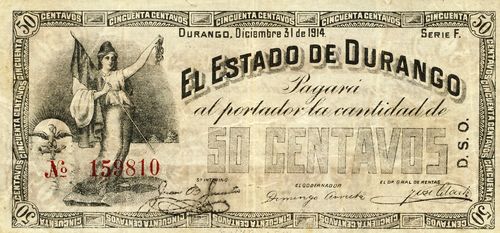
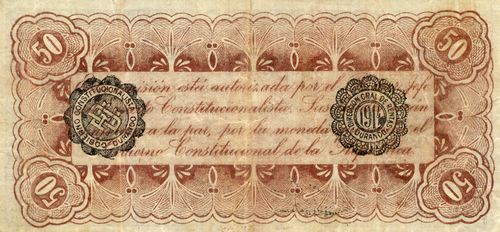 M1500 50c Estado de Durango
M1500 50c Estado de Durango
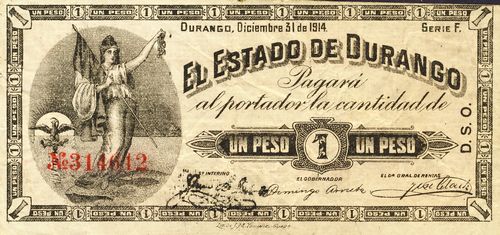
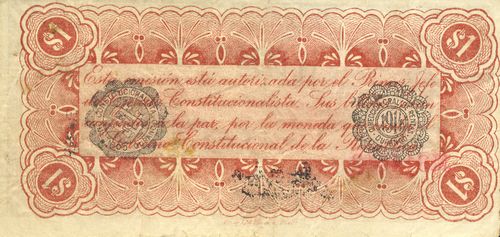 M1501a $1 Estado de Durango
M1501a $1 Estado de Durango
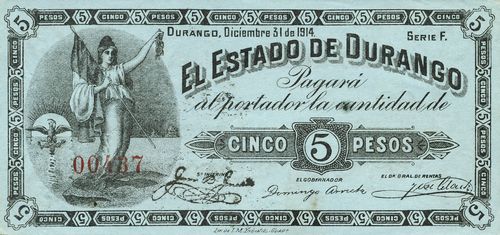 M1502 $5 Estado de Durango
M1502 $5 Estado de Durango
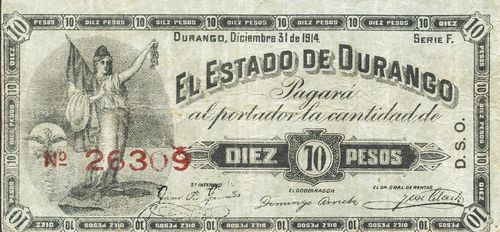 M1503a $10 Estado de Durango
M1503a $10 Estado de Durango
Known code is a vertical D.S.O on some denominations.
In a later telegram to CarranzaCEHM, Fondo XXI-4, telegram Arrieta to Carranza 13 January 1916 Arrieta acknowledged that he had issued the following amounts:
| Date on notes | Series | from | to | total number |
total value |
code | ||
| 31 December 1914 | 50c | F | 1 | 200000 | 200,000 | $100,000 | D.S.O. | includes numbers 66876CNBanxico #10911 to 182356CNBanxico #3950 |
| $1 | F | 1 | 400000 | 400,000 | 400,000 | D.S.O. | includes numbers 131248CNBanxico #3954 to 324269CNBanxico #10912 | |
| $5 | F | 00001 | 41000 | 41,000 | 205,000 | includes number 00437 to 33920CNBanxico #3996 | ||
| $10 | F | 1 | 30000 | 30,000 | 300,000 | D.S.O. | includes numbers 26309 to 30486CNBanxico #10914 | |
| $1,005,000 |
In early January 1915, Arrieta presented to Carranza a very dramatic economic situation and according to the transcripts of the telegrams a handwritten note was included with what was probably another authorization from Carranza to issue one more million pesosCEHM, Fondo XXI-4, telegram dated 31 January 1915.
On 1 December 1914 the Chihuahua government prohibited Arrieta’s notes but when Emiliano G. Saravia consulted Villa he was told that this was due to a misinterpretationLa Voz de la Revolución, Tomo 1, Núm. 17, 18 December 1914 The article wrongly suggests that all Arrieta notes were of forced circulation.. Only the Series F were invalid, as unauthorised, but a fortnight later Villa said that he was merely thinking of withdrawing the notes and replacing them with notes of other issues, so Saravia declared the notes still of forced circulationPeriódico Oficial, Durango, Tomo XXIX, Núm. 25, 20 December 1914 and on 14 February 1915 a Durango newspaper had been assured by a government employee that the 50c notes were of forced circulation, even though they were being refusedLa Voz de la Revolución, Tomo 1, Núm. 42, 14 February 1915. On 26 February the same newspaper reported that Arrieta, who still considered himself governor, had made the later issue, which was only good amongst the troops under his command. To forewarn the public it described the differences (date, printer’s imprint, etc) though Arrieta used the same templateLa Voz de la Revolución, Tomo I, Núm. 47, 26 February 1915.
So these Arrieta notes, which were so similar to the earlier Pastor Rouaix notes, entered a sort of legal limbo when Arrieta was driven out by the Villista forces.

